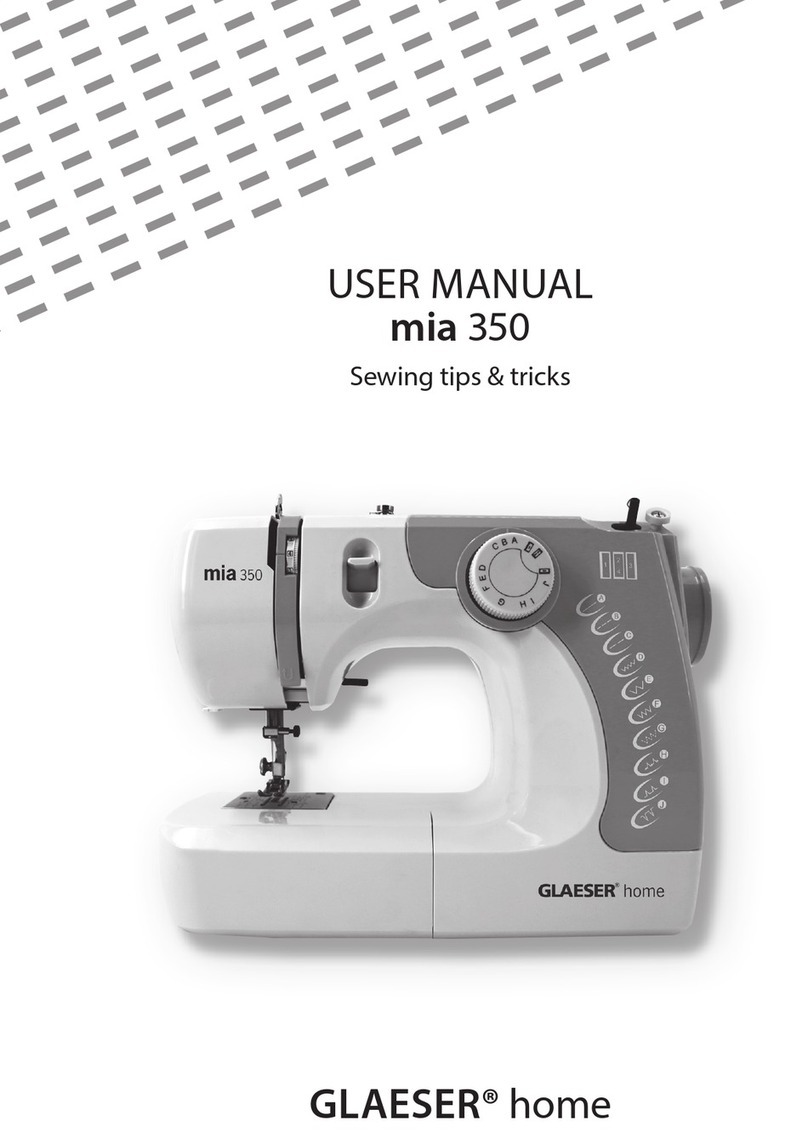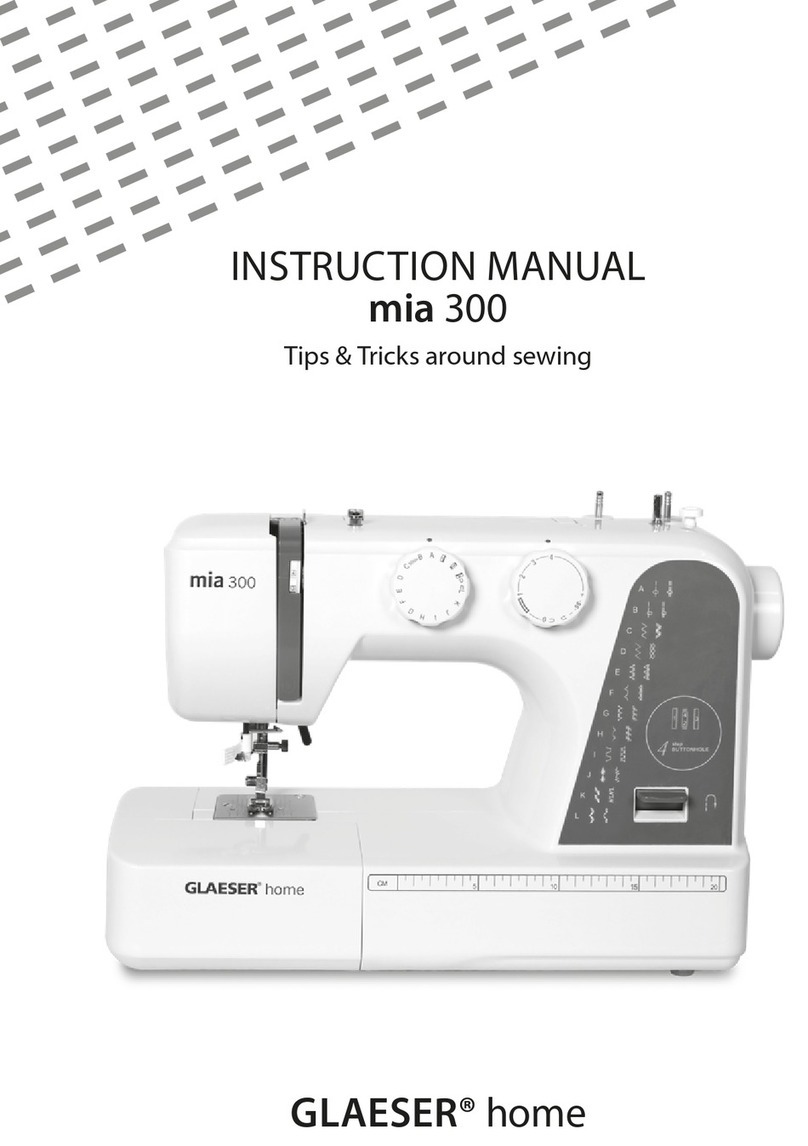Glaeser home mia 500 User manual

HANDBUCH
mia 500
Sewing tips & tricks
GLAESER® home

2
IMPORTANT SAFETY INSTRUCTIONS
When using an electrical appliance, basic safety precautions should always be followed, including
the following.
Read all instructions before using this sewing machine.
DANGER – To reduce the risk of electric shock:
1. Do not allow to be used as a toy. Close attention is necessary when this sewing machine is used
by or near children.
2. This appliance can be used by children aged from 8 years and above and persons with reduced
physical, sensory or mental capabilities or lack of experience and knowledge if they have been
given supervision or instruction concerning use of the appliance in a safe way and understand
the hazards involved. Children shall not play with the appliance. Cleaning and user maintenance
shall not be made by children without supervision.
3. Use this sewing machine only for its intended use as described in this manual. Use only attach-
ments recommended by the manufacturer as contained in this manual.
4. Never operate this sewing machine if it has a damaged cord or plug, if it is not working properly,
if it has been dropped or damaged, or dropped into water. Return the sewing machine to the
nearest authorized dealer or service center for examination,repair, electrical or mechanical
adjustment.
5. Never operate the sewing machine with any air openings blocked. Keep ventilation openings of
the sewing machine and foot control free from the accumulation of lint, dust, and loose cloth.
6. Never drop or insert any object into any opening.
7. Do not use outdoors.
8. Do not operate where aerosol (spray) products are being used or where oxygen is being admin-
istered.
9. To disconnect, turn switch to the o (”O”) position, then remove plug from outlet.
10. Do not unplug by pulling on cord. To unplug, grasp the plug, not the cord.
11. Keep ngers away from all moving parts. Special care is required around the sewing machine
needle.
12. Never sew with a damaged needle plate as this can cause needle to break.
13. Do not use bent needles.
14. Do not pull or push fabric while stitching. It may deect the needle causing it to break.
15. Switch the sewing machine o (”O”) when making any adjustments in the needle area, such as
threading needle, changing needle, threading bobbin, or changing presser foot, etc.
16. Always unplug sewing machine from the electrical outlet when removing covers, lubricating, or
when making any other user servicing adjustments mentioned in the instruction manual.
17. Attention the following to avoid injury:
· Switch o or unplug the appliance when leaving it unattended;
· Unplug the appliance before carrying out maintenance.
CAUTION: Moving parts-To reduce risk of injury, switch o before servicing.
Close cover before operating machine.

3
SAVE THESE INSTRUCTIONS
This product is for household use, or equivalent.
This appliance complies with EMC Directive 2014/30/EU covering the electromagnetic compatibility.
Please note that on disposal, this product must be safely recycled in accordance with
relevant National legislation relating to electrical/ electronic products. If in doubt please
contact your retailer for guidance.

4
Table of contents
Important safety instructions.................................................................................................................2
Knowing your sewing machine.............................................................................................................7
Machine identication ..............................................................................................................................7
Accessories ....................................................................................................................................................8
Setting up your machine..........................................................................................................................8
Power/light switch......................................................................................................................................8
Spool pins ......................................................................................................................................................9
Presser foot lifter.........................................................................................................................................9
Feed dog control.........................................................................................................................................9
Converting to free-arm sewing ...........................................................................................................10
Winding the bobbin.................................................................................................................................10
Threading the bobbin thread...............................................................................................................11
Threading the top thread.......................................................................................................................12
Using automatic needle threader.......................................................................................................13
Picking up bobbin thread ......................................................................................................................15
Needle, thread and fabric chart...........................................................................................................16
Changing the needle...............................................................................................................................17
Adjusting top thread tension ...............................................................................................................18
Straight stitching.......................................................................................................................................18
Zig zag and decorative sewing............................................................................................................18
Bobbin tension...........................................................................................................................................18
Changing presser foot.............................................................................................................................19
Functions of control panel for Mia 500.............................................................................................19
Letter pattern mode ................................................................................................................................19
Pattern number selection buttons.....................................................................................................20
Twin needle mode....................................................................................................................................20
Stitch length and stitch width/needle position adjustment buttons ...................................21
Adjust the spacing between letters...................................................................................................21
Letter pattern number selection.........................................................................................................21
Operation buttons....................................................................................................................................22
Start/Stop button .............................................................................................................................22
Needle position button ..................................................................................................................22

5
Dual purpose reverse/tacking stitch button ..........................................................................22
Sewing speed control..............................................................................................................................23
Helpful messages......................................................................................................................................23
Useful sewing tips.....................................................................................................................................24
Starting to sew...........................................................................................................................................25
Straight stitching ...................................................................................................................................25
Inserting zippers and piping.................................................................................................................26
Hand-look quilt stitch ...........................................................................................................................26
Zigzag stitching .....................................................................................................................................27
Adjusting stitch width and length......................................................................................................27
Satin stitch ...................................................................................................................................................27
Placement of patterns.............................................................................................................................27
Blindhem stitch ................................................................................................................................28
Multi-stitch zigzag ................................................................................................................................29
Shell stitch ...............................................................................................................................................29
Sewing on a button .........................................................................................................................30
Decorative and stretch stitches...........................................................................................................30
Straight stretch stitch ...........................................................................................................................30
Honeycomb stitch .................................................................................................................................31
Overedge STITCH ............................................................................................................................31
Feather stitch ..........................................................................................................................................31
Ric-rac stitch ............................................................................................................................................32
Double overlock stitch ........................................................................................................................32
Criss-cross stitch ................................................................................................................................32
Entredeux stitch ....................................................................................................................................32
Ladder stitch ............................................................................................................................................33
Pin stitch .............................................................................................................................................33
Blanket stitch .....................................................................................................................................33
Slant pin stitch ..................................................................................................................................33
Slant overedge stitch ......................................................................................................................34
Crossed stitch .........................................................................................................................................34
Table of contents
Other Glaeser home Sewing Machine manuals




















